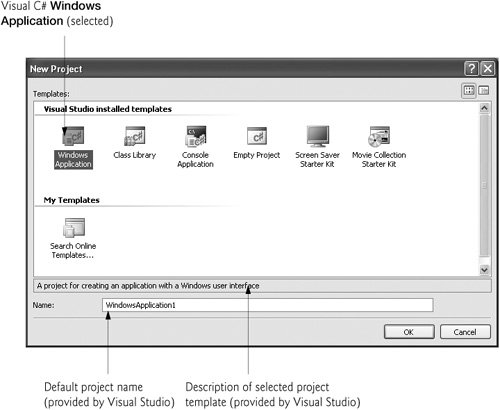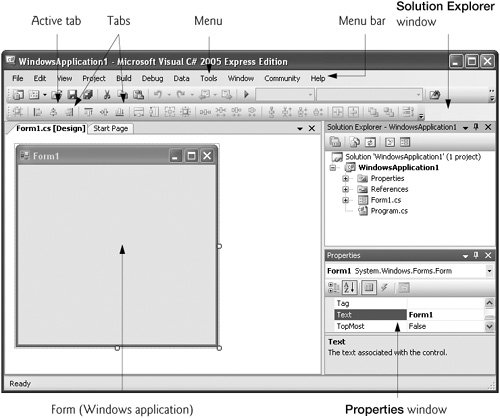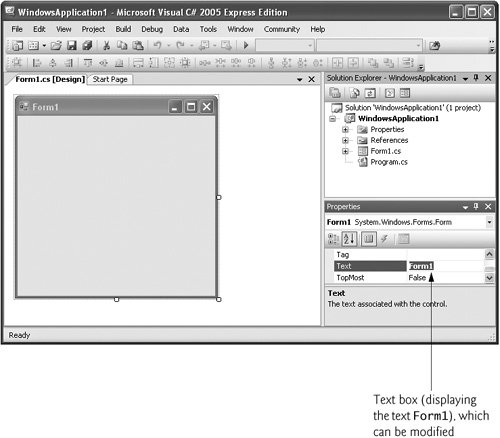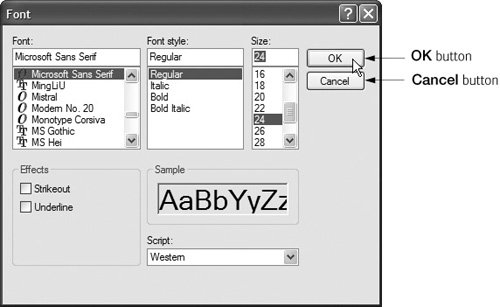Overview of the Visual Studio 2005 IDE
There are many versions of Visual Studio available. For this book, we used the Microsoft Visual C# 2005 Express Edition, which supports only the Visual C# programming language. Microsoft also offers a full version of Visual Studio 2005, which includes support for other languages in addition to Visual C#, such as Visual Basic and Visual C++. Our screen captures and discussions focus on the IDE of the Visual C# 2005 Express Edition. We assume that you have some familiarity with Windows.
Again, we use fonts to distinguish between IDE features (such as menu names and menu items) and other elements that appear in the IDE. We emphasize IDE features in a sans-serif bold Helvetica font (e.g., File menu) and emphasize other elements, such as file names (e.g., Form1.cs) and property names (discussed in Section 2.4), in a sans-serif Lucida font.
Introduction to Microsoft Visual C# 2005 Express Edition
To start Microsoft Visual C# 2005 Express Edition in Windows XP, select Start > All Programs > Visual C# 2005 Express Edition. For Windows 2000 users, select Start > Programs > Visual C# 2005 Express Edition. Once the Express Edition begins execution, the Start Page displays (Fig. 2.1). Depending on your version of Visual Studio, your Start Page may look different. For new programmers unfamiliar with Visual C#, the Start Page contains a list of links to resources in the Visual Studio 2005 IDE and on the Internet. From this point forward, we will refer to the Visual Studio 2005 IDE simply as "Visual Studio" or "the IDE." For experienced developers, this page provides links to the latest developments in Visual C# (such as updates and bug fixes) and to information on advanced programming topics. Once you start exploring the IDE, you can return to the Start Page by selecting the page from the location bar drop-down menu (Fig. 2.2), by selecting View > Other Windows > Start Page or by clicking the Start Page icon from the IDE's Toolbar (Fig. 2.9). We discuss the Toolbar and its various icons in Section 2.3. We use the > character to indicate the selection of a menu command from a menu. For example, we use the notation File > Open File to indicate that you should select the Open File command from the File menu.
Figure 2.1. Start Page in Visual C# 2005 Express Edition.

Figure 2.2. Displaying a Web page in Visual Studio.
(This item is displayed on page 38 in the print version)

Links on the Start Page
The Start Page links are organized into sectionsRecent Projects, Getting Started, Visual C# Express Headlines and MSDN: Visual Studio 2005that contain links to helpful programming resources. Clicking any link on the Start Page displays the relevant information associated with the specific link. We refer to single clicking with the left mouse button as selecting or clicking;we refer to double clicking with the left mouse button simply as double clicking.
The Recent Projects section contains information on projects you have recently created or modified. You can also open existing projects or create new ones by clicking the links in the section. The Getting Started section focuses on using the IDE to create programs, learning Visual C#, connecting to the Visual C# developer community (i.e., other software developers with whom you can communicate through newsgroups and Web sites) and providing various development tools such as starter kits. For example, clicking the link Use a Starter Kit provides you with resources and links for building a simple screen saver application or a movie collection application. The screen saver application builds a screen saver that displays current news articles. The movie collection starter kit builds an application that lets you maintain a catalog of your DVDs and VHS movies, or the application can be changed to track anything else you might collect (e.g., CDs, video games).
The Visual C# Express Headlines and MSDN: Visual Studio 2005 sections provide links to information about programming in Visual C#, including a tour of the language, new Visual C# 2005 features and online courses. To access more extensive information on Visual Studio, you can browse the MSDN (Microsoft Developer Network) online library at msdn.microsoft.com. The MSDN site contains articles, downloads and tutorials on technologies of interest to Visual Studio developers. You can also browse the Web from the IDE using Internet Explorer. To request a Web page, type its URL into the location bar (Fig. 2.2) and press the Enter keyyour computer, of course, must be connected to the Internet. (If the location bar is not already present in the IDE, select View > Other Windows > Show Browser.) The Web page that you wish to view will appear as another tab, which you can select, inside the Visual Studio IDE (Fig. 2.2).
Customizing the IDE and Creating a New Project
To begin programming in Visual C#, you must create a new project or open an existing one. There are two ways to create a new project or open an existing project. You can select either File > New Project... or File > Open Project... from the File menu, which creates a new project or opens an existing project, respectively. From the Start Page, under the Recent Projects section, you can also click the links Create: Project or Open: Project/Solution. A project is a group of related files, such as the Visual C# code and any images that might make up a program. Visual Studio 2005 organizes programs into projects and solutions, which contain one or more projects. Multiple-project solutions are used to create large-scale programs. Each of the programs we create in this book consists of a single project.
Select File > New Project... or the Create: Project... link on the Start Page to display the New Project dialog (Fig. 2.3). Dialogs are windows that facilitate user-computer communication. We will discuss the detailed process of creating new projects momentarily.
Figure 2.3. New Project dialog.

Visual Studio provides templates for several project types (Fig. 2.3). Templates are the project types users can create in Visual C#Windows applications, console applications and others (you will primarily use Windows applications and console applications in this textbook). Users can also use or create custom application templates. In this chapter, we focus on Windows applications. We discuss the Console Application template in Chapter 3, Introduction to C# Applications. A Windows application is a program that executes within a Windows operating system (e.g., Windows 2000 or Windows XP) and typically has a graphical user interface (GUI)the visual part of the program with which the user interacts. Windows applications include Microsoft software products like Microsoft Word, Internet Explorer and Visual Studio; software products created by other vendors; and customized software that you and other programmers create. You will create many Windows applications in this text. [Note: Novell sponsors an open source project called Mono that enables developers to create .NET applications for Linux, Windows and Mac OS X. Mono is based on the Ecma standards for C# and the Common Language Infrastructure (CLI). For more information on Mono, visit www.mono-project.com.]
By default, Visual Studio assigns the name WindowsApplication1 to the new project and solution (Fig. 2.3). Soon you will change the name of the project and the location where it is saved. Click OK to display the IDE in design view (Fig. 2.4), which contains all the features necessary for you to begin creating programs. The design view portion of the IDE is also known as the Windows Form Designer.
Figure 2.4. Design view of the IDE.

The gray rectangle titled Form1 (called a Form) represents the main window of the Windows application that you are creating. C# applications can have multiple Forms (windows); however, most of the applications you will create in this text use only one Form. Later in the chapter, you will learn how to customize the Form by adding controls (i.e., reusable components) to a programin this case, a Label and a PictureBox (as you will see in Fig. 2.27). A Label typically contains descriptive text (e.g., "Welcome to Visual C#!"), and a PictureBox displays images, such as the Deitel bug mascot. Visual Studio has over 65 preexisting controls you can use to build and customize your programs. Many of these controls are defined and used throughout this book. In addition to the controls provided with Visual C# 2005 Express or Visual Studio 2005, there are many other controls available from third parties. You can download several third party controls from msdn.microsoft.com/vcsharp/downloads/components/default.aspx.
As you begin programming, you will work with controls that are not necessarily part of your program, but rather are part of the FCL. As you place controls on the form, you can modify their properties (discussed in detail in Section 2.4) by entering alternative text in a text box (Fig. 2.5) or selecting options then pressing a button, such as OK or Cancel, as shown in Fig. 2.6.
Figure 2.5. Example of a text box control in the Visual Studio IDE.

Figure 2.6. Examples of buttons in the Visual Studio IDE.
(This item is displayed on page 42 in the print version)

Collectively, the Form and controls constitute the program's GUI. Users enter data (input) into the program in a variety of ways, including typing at the keyboard, clicking the mouse buttons and typing into GUI controls, such as TextBoxes. Programs use the GUI to display instructions and other information (output) for users to read. For example, the New Project dialog in Fig. 2.3 presents a GUI where the user clicks the mouse button to select a project template, then inputs a project name from the keyboard (note that the figure is still showing the default project name WindowsApplication1 supplied by Visual Studio).
The name of each open document is listed on a tabin Fig. 2.4, the open documents are Form1.cs [Design] and the Start Page. To view a document, click its tab. Tabs facilitate easy access to multiple open documents. The active tab (the tab of the document currently displayed in the IDE) is displayed in bold text (e.g., Form1.cs [Design] in Fig. 2.4) and is positioned in front of all the other tabs.
Preface
Index
Introduction to Computers, the Internet and Visual C#
- Introduction
- What Is a Computer?
- Computer Organization
- Early Operating Systems
- Personal Computing, Distributed Computing and Client/Server Computing
- Hardware Trends
- Microsofts Windows® Operating System
- Machine Languages, Assembly Languages and High-Level Languages
- C#
- C, C++, Java and Visual Basic
- Other High-Level Languages
- The Internet and the World Wide Web
- Extensible Markup Language (XML)
- Microsofts .NET
- The .NET Framework and the Common Language Runtime
- Test-Driving a C# Application
- Software Engineering Case Study: Introduction to Object Technology and the UML
- Wrap-Up
- Web Resources
- Summary
- Terminology
- Self-Review Exercises
- Exercises
Introduction to the Visual C# 2005 Express Edition IDE
- Introduction
- Overview of the Visual Studio 2005 IDE
- Menu Bar and Toolbar
- Navigating the Visual Studio 2005 IDE
- Using Help
- Using Visual Programming to Create a Simple Program Displaying Text and an Image
- Wrap-Up
- Web Resources
- Summary
- Terminology
- Self-Review Exercises
- Exercises
Introduction to C# Applications
- Introduction
- A Simple C# Application: Displaying a Line of Text
- Creating Your Simple Application in Visual C# Express
- Modifying Your Simple C# Application
- Formatting Text with Console.Write and Console.WriteLine
- Another C# Application: Adding Integers
- Memory Concepts
- Arithmetic
- Decision Making: Equality and Relational Operators
- (Optional) Software Engineering Case Study: Examining the ATM Requirements Document
- Wrap-Up
- Summary
- Terminology
- Self-Review Exercises
- Exercises
Introduction to Classes and Objects
- Introduction
- Classes, Objects, Methods, Properties and Instance Variables
- Declaring a Class with a Method and Instantiating an Object of a Class
- Declaring a Method with a Parameter
- Instance Variables and Properties
- UML Class Diagram with a Property
- Software Engineering with Properties and set and get Accessors
- Value Types vs. Reference Types
- Initializing Objects with Constructors
- Floating-Point Numbers and Type decimal
- (Optional) Software Engineering Case Study: Identifying the Classes in the ATM Requirements Document
- Wrap-Up
- Summary
- Terminology
- Self-Review Exercises
- Exercises
Control Statements: Part 1
- Introduction
- Algorithms
- Pseudocode
- Control Structures
- if Single-Selection Statement
- if...else Double-Selection Statement
- while Repetition Statement
- Formulating Algorithms: Counter-Controlled Repetition
- Formulating Algorithms: Sentinel-Controlled Repetition
- Formulating Algorithms: Nested Control Statements
- Compound Assignment Operators
- Increment and Decrement Operators
- Simple Types
- (Optional) Software Engineering Case Study: Identifying Class Attributes in the ATM System
- Wrap-Up
- Summary
- Terminology
- Self-Review Exercises
- Exercises
Control Statements: Part 2
- Introduction
- Essentials of Counter-Controlled Repetition
- for Repetition Statement
- Examples Using the for Statement
- do...while Repetition Statement
- switch Multiple-Selection Statement
- break and continue Statements
- Logical Operators
- Structured Programming Summary
- (Optional) Software Engineering Case Study: Identifying Objects States and Activities in the ATM System
- Wrap-Up
- Summary
- Terminology
- Self-Review Exercises
- Exercises
Methods: A Deeper Look
- Introduction
- Packaging Code in C#
- static Methods, static Variables and Class Math
- Declaring Methods with Multiple Parameters
- Notes on Declaring and Using Methods
- Method Call Stack and Activation Records
- Argument Promotion and Casting
- The Framework Class Library
- Case Study: Random-Number Generation
- Case Study: A Game of Chance (Introducing Enumerations)
- Scope of Declarations
- Method Overloading
- Recursion
- Passing Arguments: Pass-by-Value vs. Pass-by-Reference
- (Optional) Software Engineering Case Study: Identifying Class Operations in the ATM System
- Wrap-Up
- Summary
- Terminology
- Self-Review Exercises
- Exercises
Arrays
- Introduction
- Arrays
- Declaring and Creating Arrays
- Examples Using Arrays
- Case Study: Card Shuffling and Dealing Simulation
- foreach Statement
- Passing Arrays and Array Elements to Methods
- Passing Arrays by Value and by Reference
- Case Study: Class GradeBook Using an Array to Store Grades
- Multidimensional Arrays
- Case Study: Class GradeBook Using a Rectangular Array
- Variable-Length Argument Lists
- Using Command-Line Arguments
- (Optional) Software Engineering Case Study: Collaboration Among Objects in the ATM System
- Wrap-Up
- Summary
- Terminology
- Self-Review Exercises
- Exercises
- Special Section: Building Your Own Computer
Classes and Objects: A Deeper Look
- Introduction
- Time Class Case Study
- Controlling Access to Members
- Referring to the Current Objects Members with the this Reference
- Indexers
- Time Class Case Study: Overloaded Constructors
- Default and Parameterless Constructors
- Composition
- Garbage Collection and Destructors
- static Class Members
- readonly Instance Variables
- Software Reusability
- Data Abstraction and Encapsulation
- Time Class Case Study: Creating Class Libraries
- internal Access
- Class View and Object Browser
- (Optional) Software Engineering Case Study: Starting to Program the Classes of the ATM System
- Wrap-Up
- Summary
- Terminology
- Self-Review Exercises
- Exercises
Object-Oriented Programming: Inheritance
- Introduction
- Base Classes and Derived Classes
- protected Members
- Relationship between Base Classes and Derived Classes
- Constructors in Derived Classes
- Software Engineering with Inheritance
- Class object
- Wrap-Up
- Summary
- Terminology
- Self-Review Exercises
- Exercises
Polymorphism, Interfaces & Operator Overloading
- Introduction
- Polymorphism Examples
- Demonstrating Polymorphic Behavior
- Abstract Classes and Methods
- Case Study: Payroll System Using Polymorphism
- sealed Methods and Classes
- Case Study: Creating and Using Interfaces
- Operator Overloading
- (Optional) Software Engineering Case Study: Incorporating Inheritance and Polymorphism into the ATM System
- Wrap-Up
- Summary
- Terminology
- Self-Review Exercises
- Exercises
Exception Handling
- Introduction
- Exception Handling Overview
- Example: Divide by Zero Without Exception Handling
- Example: Handling DivideByZeroExceptions and FormatExceptions
- .NET Exception Hierarchy
- finally Block
- Exception Properties
- User-Defined Exception Classes
- Wrap-Up
- Summary
- Terminology
- Self-Review Exercises
- Exercises
Graphical User Interface Concepts: Part 1
- Introduction
- Windows Forms
- Event Handling
- Control Properties and Layout
- Labels, TextBoxes and Buttons
- GroupBoxes and Panels
- CheckBoxes and RadioButtons
- PictureBoxes
- ToolTips
- NumericUpDown Control
- Mouse-Event Handling
- Keyboard-Event Handling
- Wrap-Up
- Summary
- Terminology
- Self-Review Exercises
- Answers To Self-Review Exercises
- Exercises
Graphical User Interface Concepts: Part 2
- Introduction
- Menus
- MonthCalendar Control
- DateTimePicker Control
- LinkLabel Control
- ListBox Control
- CheckedListBox Control
- ComboBox Control
- TreeView Control
- ListView Control
- TabControl Control
- Multiple Document Interface (MDI) Windows
- Visual Inheritance
- User-Defined Controls
- Wrap-Up
- Summary
- Terminology
- Self-Review Exercises
- Exercises
Multithreading
- Introduction
- Thread States: Life Cycle of a Thread
- Thread Priorities and Thread Scheduling
- Creating and Executing Threads
- Thread Synchronization and Class Monitor
- Producer/Consumer Relationship without Thread Synchronization
- Producer/Consumer Relationship with Thread Synchronization
- Producer/Consumer Relationship: Circular Buffer
- Multithreading with GUIs
- Wrap-Up
- Summary
- Terminology
- Self-Review Exercises
- Exercises
Strings, Characters and Regular Expressions
- Introduction
- Fundamentals of Characters and Strings
- string Constructors
- string Indexer, Length Property and CopyTo Method
- Comparing strings
- Locating Characters and Substrings in strings
- Extracting Substrings from strings
- Concatenating strings
- Miscellaneous string Methods
- Class StringBuilder
- Length and Capacity Properties, EnsureCapacity Method and Indexer of Class StringBuilder
- Append and AppendFormat Methods of Class StringBuilder
- Insert, Remove and Replace Methods of Class StringBuilder
- Char Methods
- Card Shuffling and Dealing Simulation
- Regular Expressions and Class Regex
- Wrap-Up
- Summary
- Terminology
- Self-Review Exercises
- Exercises
Graphics and Multimedia
- Introduction
- Drawing Classes and the Coordinate System
- Graphics Contexts and Graphics Objects
- Color Control
- Font Control
- Drawing Lines, Rectangles and Ovals
- Drawing Arcs
- Drawing Polygons and Polylines
- Advanced Graphics Capabilities
- Introduction to Multimedia
- Loading, Displaying and Scaling Images
- Animating a Series of Images
- Windows Media Player
- Microsoft Agent
- Wrap-Up
- Summary
- Terminology
- Self-Review Exercises
- Exercises
Files and Streams
- Introduction
- Data Hierarchy
- Files and Streams
- Classes File and Directory
- Creating a Sequential-Access Text File
- Reading Data from a Sequential-Access Text File
- Serialization
- Creating a Sequential-Access File Using Object Serialization
- Reading and Deserializing Data from a Sequential-Access Text File
- Wrap-Up
- Summary
- Terminology
- Self-Review Exercises
- Exercises
Extensible Markup Language (XML)
- Introduction
- XML Basics
- Structuring Data
- XML Namespaces
- Document Type Definitions (DTDs)
- W3C XML Schema Documents
- (Optional) Extensible Stylesheet Language and XSL Transformations
- (Optional) Document Object Model (DOM)
- (Optional) Schema Validation with Class XmlReader
- (Optional) XSLT with Class XslCompiledTransform
- Wrap-Up
- Web Resources
- Summary
- Terminology
- Self-Review Exercises
- Exercises
Database, SQL and ADO.NET
- Introduction
- Relational Databases
- Relational Database Overview: Books Database
- SQL
- ADO.NET Object Model
- Programming with ADO.NET: Extracting Information from a Database
- Querying the Books Database
- Programming with ADO.NET: Address Book Case Study
- Using a DataSet to Read and Write XML
- Wrap-Up
- Web Resources
- Summary
- Terminology
- Self-Review Exercises
- Exercises
ASP.NET 2.0, Web Forms and Web Controls
- Introduction
- Simple HTTP Transactions
- Multitier Application Architecture
- Creating and Running a Simple Web-Form Example
- Web Controls
- Session Tracking
- Case Study: Connecting to a Database in ASP.NET
- Case Study: Secure Books Database Application
- Wrap-Up
- Web Resources
- Summary
- Terminology
- Self-Review Exercises
- Exercises
Web Services
- Introduction
- .NET Web Services Basics
- Simple Object Access Protocol (SOAP)
- Publishing and Consuming Web Services
- Session Tracking in Web Services
- Using Web Forms and Web Services
- User-Defined Types in Web Services
- Wrap-Up
- Web Resources
- Summary
- Terminology
- Self-Review Exercises
- Exercises
Networking: Streams-Based Sockets and Datagrams
- Introduction
- Connection-Oriented vs. Connectionless Communication
- Protocols for Transporting Data
- Establishing a Simple TCP Server (Using Stream Sockets)
- Establishing a Simple TCP Client (Using Stream Sockets)
- Client/Server Interaction with Stream-Socket Connections
- Connectionless Client/Server Interaction with Datagrams
- Client/Server Tic-Tac-Toe Using a Multithreaded Server
- WebBrowser Control
- .NET Remoting
- Wrap-Up
- Summary
- Terminology
- Self-Review Exercises
- Exercises
Searching and Sorting
- Introduction
- Searching Algorithms
- Sorting Algorithms
- Wrap-Up
- Summary
- Terminology
- Self-Review Exercises
- Exercises
Data Structures
- Introduction
- Simple-Type structs, Boxing and Unboxing
- Self-Referential Classes
- Linked Lists
- Stacks
- Queues
- Trees
- Wrap-Up
- Summary
- Terminology
- Self-Review Exercises
- Exercises
Generics
- Introduction
- Motivation for Generic Methods
- Generic Method Implementation
- Type Constraints
- Overloading Generic Methods
- Generic Classes
- Notes on Generics and Inheritance
- Wrap-Up
- Summary
- Terminology
- Self-Review Exercises
- Exercises
Collections
- Introduction
- Collections Overview
- Class Array and Enumerators
- Non-Generic Collections
- Generic Collections
- Synchronized Collections
- Wrap-Up
- Summary
- Terminology
- Self-Review Exercises
- Exercises
Appendix A. Operator Precedence Chart
Appendix B. Number Systems
- B.1. Introduction
- B.2. Abbreviating Binary Numbers as Octal and Hexadecimal Numbers
- B.3. Converting Octal and Hexadecimal Numbers to Binary Numbers
- B.4. Converting from Binary, Octal or Hexadecimal to Decimal
- B.5. Converting from Decimal to Binary, Octal or Hexadecimal
- B.6. Negative Binary Numbers: Twos Complement Notation
- Summary
- Terminology
- Self-Review Exercises
- Exercises
Appendix C. Using the Visual Studio 2005 Debugger
- C.1. Introduction
- C.2. Breakpoints and the Continue Command
- C.3. The Locals and Watch Windows
- C.4. Controlling Execution Using the Step Into, Step Over, Step Out and Continue Commands
- C.5. Other Features
- C.6. Wrap-Up
- Summary
- Terminology
- Self-Review Exercises
Appendix D. ASCII Character Set
Appendix E. Unicode®
- E.1. Introduction
- E.2. Unicode Transformation Formats
- E.3. Characters and Glyphs
- E.4. Advantages/Disadvantages of Unicode
- E.5. Using Unicode
- E.6. Character Ranges
- Summary
- Terminology
- Self-Review Exercises
- Answers to Self-Review exercises
- Exercises
Appendix F. Introduction to XHTML: Part 1
- F.1. Introduction
- F.2. Editing XHTML
- F.3. First XHTML Example
- F.4. W3C XHTML Validation Service
- F.5. Headers
- F.6. Linking
- F.7. Images
- F.8. Special Characters and More Line Breaks
- F.9. Unordered Lists
- F.10. Nested and Ordered Lists
- F.11. Web Resources
Appendix G. Introduction to XHTML: Part 2
- G.1. Introduction
- G.2. Basic XHTML Tables
- G.3. Intermediate XHTML Tables and Formatting
- G.4. Basic XHTML Forms
- G.5. More Complex XHTML Forms
- G.6. Internal Linking
- G.7. Creating and Using Image Maps
- G.8. meta Elements
- G.9. frameset Element
- G.10. Nested framesets
- G.11. Web Resources
Appendix H. HTML/XHTML Special Characters
Appendix I. HTML/XHTML Colors
Appendix J. ATM Case Study Code
- Appendix J. ATM Case Study Code
- J.1. ATM Case Study Implementation
- J.2. Class ATM
- J.3. Class Screen
- J.4. Class Keypad
- J.5. Class CashDispenser
- J.6. Class DepositSlot
- J.7. Class Account
- J.8. Class BankDatabase
- J.9. Class Transaction
- J.10. Class BalanceInquiry
- J.11. Class Withdrawal
- J.12. Class Deposit
- J.13. Class ATMCaseStudy
- J.14. Wrap-Up
Appendix K. UML 2: Additional Diagram Types
Appendix L. Simple Types
Index
EAN: 2147483647
Pages: 600
